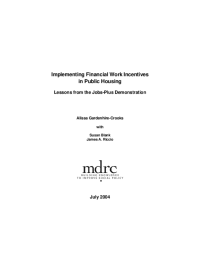Implementing Financial Work Incentives in Public Housing
Lessons from the Jobs-Plus Demonstration
Overview
Public housing residents who leave welfare for work often see their rents rise in tandem with their higher household income, creating a potential disincentive for them to find or keep jobs. The Jobs-Plus Community Revitalization Initiative for Public Housing Families incorporates the first large-scale test of new rent rules that help make low-wage work pay. Drawing on the experiences of housing authorities in six cities, this report presents lessons on the implementation and use of these innovative work incentives as part of a comprehensive package of employment-related assistance.
Traditionally, public housing rents are set at 30 percent of a household’s income. The Jobs-Plus rent incentives changed this policy in a variety of ways. Some sites continued to calculate rent as a percentage of household income but dropped the rate below the standard 30 percent level. Others established flat rents, which kept rent the same even when earnings increased household income. Most sites enriched their plans with other benefits to reward sustained employment. The plans, which were phased in between 1998 and 2000, reflect — and substantially extend — the public housing rent reforms established by 1998 federal housing legislation.
Key Findings
- Marketing and explaining rent-based work incentives required sustained, varied, and broadly targeted efforts. The constant arrival of new residents and, in some sites, the range of ethnic groups with vastly different languages and cultures made outreach a challenge. This challenge was compounded by the complex nature of most plans. Helpful tactics in publicizing and clarifying the plans included involving housing managers and resident volunteers in marketing campaigns and seeking diverse forums to explain incentives. Several sites focused outreach on already-employed residents and may have missed opportunities to use incentives to encourage nonworkers to seek employment.
- Residents’ use of the incentives was substantial. The target population for Jobs-Plus included all households headed by residents who were of working age and nondisabled, whether or not they were already employed. Across all sites, 48 percent of such households used rent incentives. In three sites, well over half did so. However, some eligible residents did not use the incentives because they remained unaware of or confused by the offer, were suspicious of a housing authority initiative, or had other reasons for not participating in the plan.
- Residents’ use of the incentives varied dramatically by site. Depending on the site, between 19 percent and 75 percent of all targeted households eventually took advantage of the rent incentives offer. (While only working residents qualified for incentives, site differences in employment rates do not account for this variation.) In general, the rates were highest at sites where housing authority managers actively partnered with Jobs-Plus to promote the incentives.
- Incentives created welcome boosts in household incomes and reportedly encouraged additional work effort among residents who were already employed. The money saved on rent was mostly used to make basic purchases and pay bills. Strikingly, given the generally modest incomes of public housing tenants, some households managed to increase their savings. Reports of some staff and residents suggest that the relationship between incentives and work behavior was mixed, with these reforms doing more to sustain and even increase work among employed residents than to induce nonworkers to find jobs.
A subsequent report will present findings on how the Jobs-Plus program's full package of incentives, services, and supports affected residents’ employment, earnings, and other outcomes.






